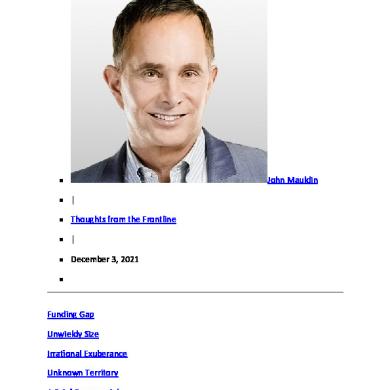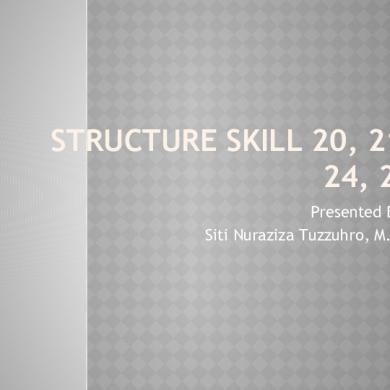* The preview only shows a few pages of manuals at random. You can get the complete content by filling out the form below.
Description
Capital Structure • Capital structure refers to the amount of debt and/or equity employed by a firm to fund its operations and finance its assets. A firm’s capital structure is typically expressed as a debt to equity ratio or debt-to-capital ratio.
Pattern of Capital Structure • Equity Share only • Equity and Preferences Share • Equity Shares and Debentures • Equity Shares, preferences Shares and Debentures. The use of long term fixed interest bearing debt and preference share capital along with equity shares is called Financial Leverage or Trading on Equity. ABC Co. has currently an all equity capital structure consisting of 15,000 equity shares of Rs. 100 each. The management is planning to raise another Rs. 25 lakhs to finance a major programme of expansion and is considering three alternative methods of financing: i.
To issue 25,000 equity shares of Rs. 100 each
ii.
To issue 25,000, 8% debentures of Rs. 100 each
iii.
To issue 25,000, 8% Preference shares of Rs. 100 each
The company’s expected earnings before interest and taxes will be Rs. 8 lakhs. Assuming a corporate tax rate of 50%. Determine the earnings per share (EPS) in each alternative and comment which alternative is best and why?
Particulars
Alternative I (in lakhs) Equity
Alternative II (in lakhs) 8%Debenture
Alternative III (in lakhs) 8%Preference
Earnings before Interest and Tax(EBIT)
8.00
8.00
8.00
Less: Interest
-
2.00
-
Earnings after Interest but before Tax
8.00
6.00
8.00
Less: Tax@ 50%
4.00
3.00
4.00
Earnings after Tax (EAT)
4.00
3.00
4.00
Less: Preference Dividend
-
-
2.00
Earnings available to Equity Shareholders (a)
4.00
3.00
2.00
No. of equity shares (b)
40,000
15,000
15,000
Earnings Per Share(EPS) (a/b)
10
20
13.33
Comment: Alternative II should be selected as it gives Highest EPS.
Optimal Capital Structure • Optimal capital structure is a financial measurement that firms use to determine the best mix of debt and equity financing to use for operations and expansions. • This structure seeks to lower the cost of capital so that a firm is less dependent on creditors and more able to finance its core operations through equity. • To calculate the optimal capital structure of a firm, analysts calculate the (WACC) to determine the level of risk that makes the expected return on capital greater than the cost of capital.
Net Income Approach • The Net Income Approach suggests that with the increase in leverage (proportion of debt), the WACC decreases and the value of firm increases. Assumptions of Net Income Approach: • The increase in debt will not affect the confidence levels of the investors. • There are only two sources of finance; debt and equity. There are no sources of finance like Preference Share Capital and Retained Earning. • All companies have uniform dividend pay out ratio; it is 1. • There is no floatation cost, no transaction cost and corporate dividend tax. • Capital market is perfect, it means information about all companies are available to all investors and there are no chances of over pricing or under pricing of security. Further it means that all investors are rational. So, all investors want to maximize their return with minimization of risk. • All sources of finance are for infinity. There are no redeemable sources of finance.
Net Operating Income Approach This approach believes that the value of the firm is not affected by the change of debt component in the capital structure. It assumes that the benefit that a firm derives by infusion of debt is negated by the simultaneous increase in the required rate of return by the equity shareholders. The NOI approach is based on following assumptions: (i) There are no corporate taxes. (ii) Cost of debt remains constant at all level of debt. (iii)Overall cost of capital remains constant. (iv) Value of the firm depends on expected net operating income and overall capitalization rate or the opportunity cost of capital. (v) Net operating income of the firm is not affected by the degree of financial leverage. (vi) The operating risk or business risk does not change with the change in debt equity mix. (vii)WACC does not change with the change in financial leverage
Net Operating Income Approach
The Traditional Approach
• Assumptions under Traditional Approach: 1.The rate of interest on debt remains constant for a certain period and thereafter with an increase in leverage, it increases. 2.The expected rate by equity shareholders remains constant or increase gradually. After that, the equity shareholders starts perceiving a financial risk and then from the optimal point and the expected rate increases speedily. 3.As a result of the activity of rate of interest and expected rate of return, the WACC first decreases and then increases. The lowest point on the curve is optimal capital structure.
The Traditional Approach
Modigliani and Miller Approach: (a) Theory of Irrelevance: Irrelevancy theory suggests that the valuation of a firm is irrelevant to the capital structure of a company. Whether a firm is highly leveraged or has a lower debt component in the financing mix has no bearing on the value of a firm.
Assumptions of Modigliani and Miller Approach • There are no taxes. • Transaction cost for buying and selling securities, as well as the bankruptcy cost, is nil. • There is a symmetry of information. This means that an investor will have access to the same information that a corporation would and investors will thus behave rationally. • The cost of borrowing is the same for investors and companies. • There is no floatation cost, such as an underwriting commission, payment to merchant bankers, advertisement expenses, etc. • There is no corporate dividend tax.
(b) Theory of Relevance: This approach with corporate taxes does acknowledge tax savings and thus infers that a change in the debtequity ratio has an effect on the WACC. This means that the higher the debt, the lower the WACC.













